Page 3269 of 4555
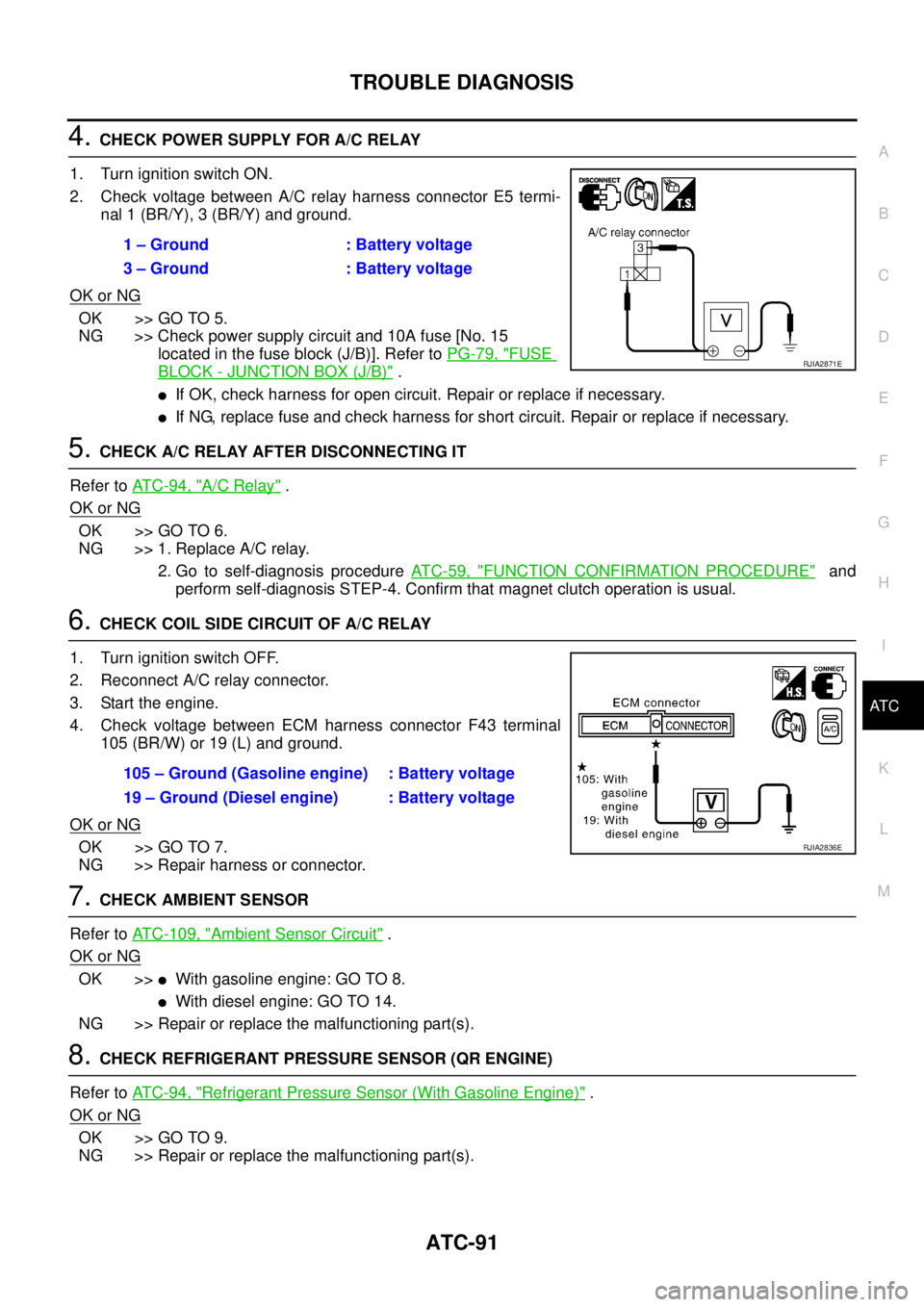
TROUBLE DIAGNOSIS
ATC-91
C
D
E
F
G
H
I
K
L
MA
B
AT C
4. CHECK POWER SUPPLY FOR A/C RELAY
1. Turn ignition switch ON.
2. Check voltage between A/C relay harness connector E5 termi-
nal 1 (BR/Y), 3 (BR/Y) and ground.
OK or NG
OK >> GO TO 5.
NG >> Check power supply circuit and 10A fuse [No. 15
located in the fuse block (J/B)]. Refer to PG-79, "
FUSE
BLOCK - JUNCTION BOX (J/B)" .
�If OK, check harness for open circuit. Repair or replace if necessary.
�If NG, replace fuse and check harness for short circuit. Repair or replace if necessary.
5. CHECK A/C RELAY AFTER DISCONNECTING IT
Refer to AT C - 9 4 , "
A/C Relay" .
OK or NG
OK >> GO TO 6.
NG >> 1. Replace A/C relay.
2. Go to self-diagnosis procedure AT C - 5 9 , "
FUNCTION CONFIRMATION PROCEDURE" and
perform self-diagnosis STEP-4. Confirm that magnet clutch operation is usual.
6. CHECK COIL SIDE CIRCUIT OF A/C RELAY
1. Turn ignition switch OFF.
2. Reconnect A/C relay connector.
3. Start the engine.
4. Check voltage between ECM harness connector F43 terminal
105 (BR/W) or 19 (L) and ground.
OK or NG
OK >> GO TO 7.
NG >> Repair harness or connector.
7. CHECK AMBIENT SENSOR
Refer to ATC-109, "
Ambient Sensor Circuit" .
OK or NG
OK >>�With gasoline engine: GO TO 8.
�With diesel engine: GO TO 14.
NG >> Repair or replace the malfunctioning part(s).
8. CHECK REFRIGERANT PRESSURE SENSOR (QR ENGINE)
Refer to AT C - 9 4 , "
Refrigerant Pressure Sensor (With Gasoline Engine)" .
OK or NG
OK >> GO TO 9.
NG >> Repair or replace the malfunctioning part(s).1 – Ground : Battery voltage
3 – Ground : Battery voltage
RJIA2871E
105 – Ground (Gasoline engine) : Battery voltage
19 – Ground (Diesel engine) : Battery voltage
RJIA2836E
Page 3272 of 4555
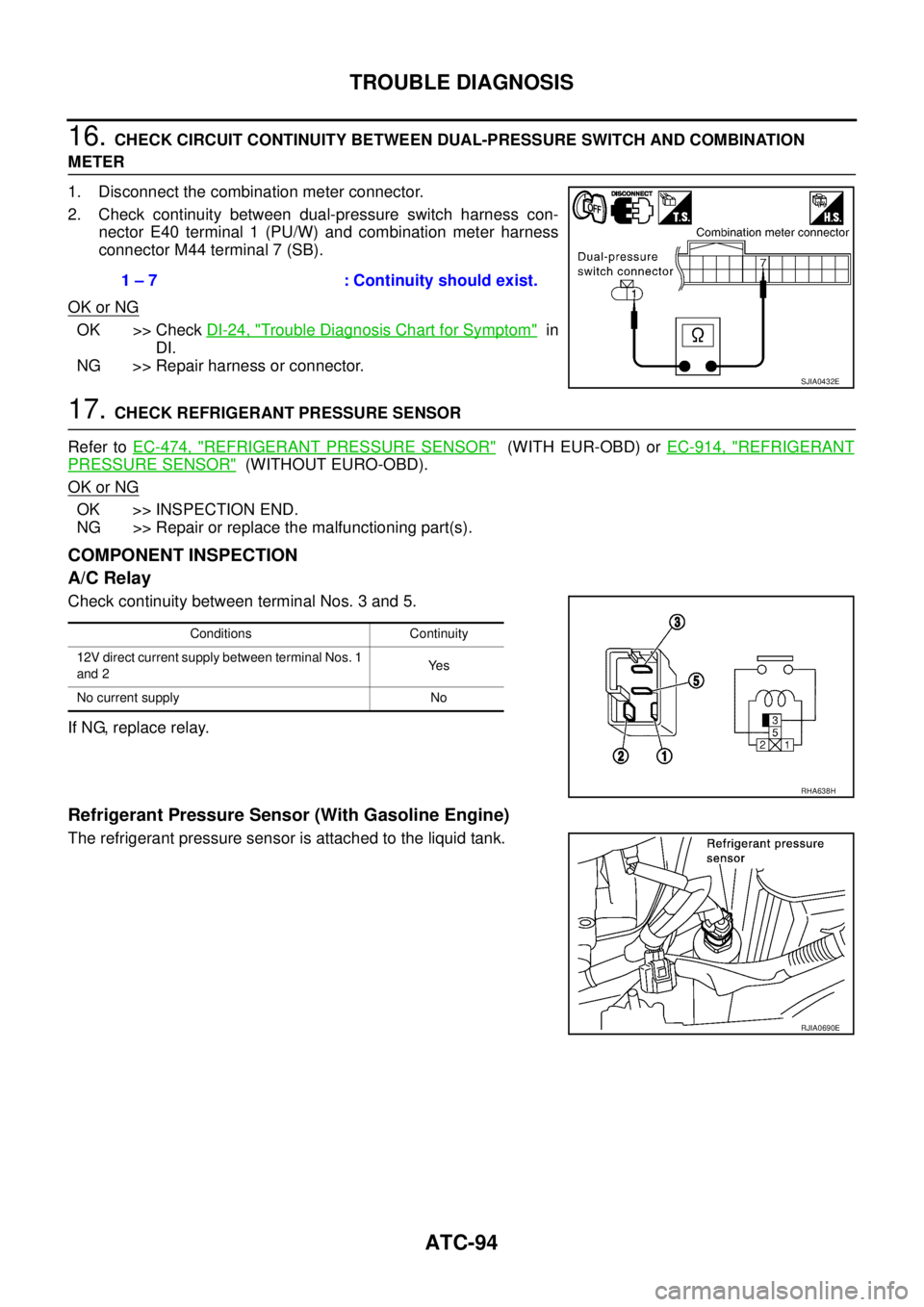
ATC-94
TROUBLE DIAGNOSIS
16. CHECK CIRCUIT CONTINUITY BETWEEN DUAL-PRESSURE SWITCH AND COMBINATION
METER
1. Disconnect the combination meter connector.
2. Check continuity between dual-pressure switch harness con-
nector E40 terminal 1 (PU/W) and combination meter harness
connector M44 terminal 7 (SB).
OK or NG
OK >> Check DI-24, "Trouble Diagnosis Chart for Symptom" in
DI.
NG >> Repair harness or connector.
17. CHECK REFRIGERANT PRESSURE SENSOR
Refer to EC-474, "
REFRIGERANT PRESSURE SENSOR" (WITH EUR-OBD) or EC-914, "REFRIGERANT
PRESSURE SENSOR" (WITHOUT EURO-OBD).
OK or NG
OK >> INSPECTION END.
NG >> Repair or replace the malfunctioning part(s).
COMPONENT INSPECTION
A/C Relay
Check continuity between terminal Nos. 3 and 5.
If NG, replace relay.
Refrigerant Pressure Sensor (With Gasoline Engine)
The refrigerant pressure sensor is attached to the liquid tank.1 – 7 : Continuity should exist.
SJIA0432E
Conditions Continuity
12V direct current supply between terminal Nos. 1
and 2Ye s
No current supply No
RHA638H
RJIA0690E
Page 3281 of 4555
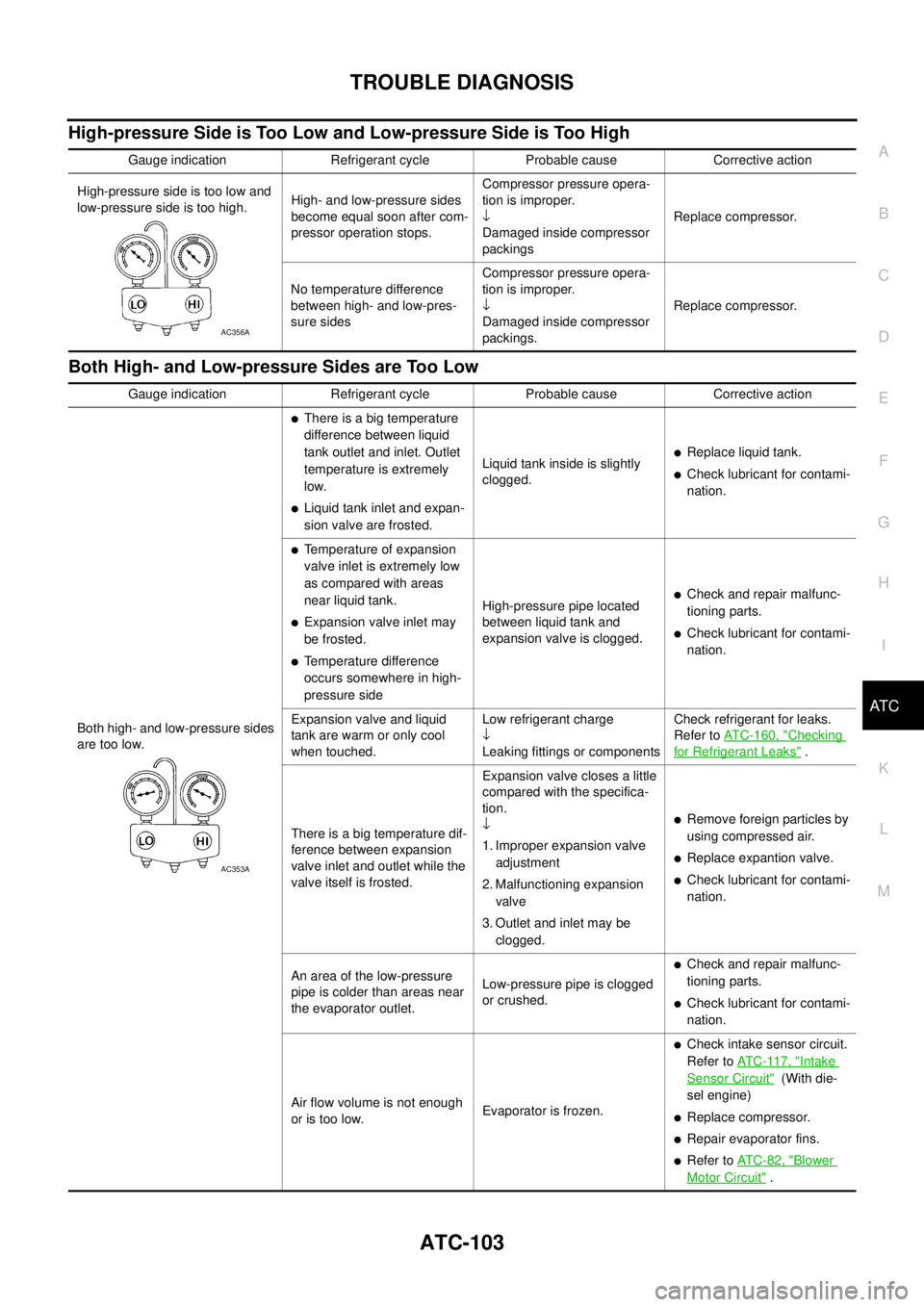
TROUBLE DIAGNOSIS
ATC-103
C
D
E
F
G
H
I
K
L
MA
B
AT C
High-pressure Side is Too Low and Low-pressure Side is Too High
Both High- and Low-pressure Sides are Too Low
Gauge indication Refrigerant cycle Probable cause Corrective action
High-pressure side is too low and
low-pressure side is too high.High- and low-pressure sides
become equal soon after com-
pressor operation stops.Compressor pressure opera-
tion is improper.
↓
Damaged inside compressor
packingsReplace compressor.
No temperature difference
between high- and low-pres-
sure sidesCompressor pressure opera-
tion is improper.
↓
Damaged inside compressor
packings.Replace compressor.
AC356A
Gauge indication Refrigerant cycle Probable cause Corrective action
Both high- and low-pressure sides
are too low.
�There is a big temperature
difference between liquid
tank outlet and inlet. Outlet
temperature is extremely
low.
�Liquid tank inlet and expan-
sion valve are frosted.Liquid tank inside is slightly
clogged.
�Replace liquid tank.
�Check lubricant for contami-
nation.
�Temperature of expansion
valve inlet is extremely low
as compared with areas
near liquid tank.
�Expansion valve inlet may
be frosted.
�Temperature difference
occurs somewhere in high-
pressure sideHigh-pressure pipe located
between liquid tank and
expansion valve is clogged.
�Check and repair malfunc-
tioning parts.
�Check lubricant for contami-
nation.
Expansion valve and liquid
tank are warm or only cool
when touched.Low refrigerant charge
↓
Leaking fittings or componentsCheck refrigerant for leaks.
Refer to ATC-160, "
Checking
for Refrigerant Leaks" .
There is a big temperature dif-
ference between expansion
valve inlet and outlet while the
valve itself is frosted.Expansion valve closes a little
compared with the specifica-
tion.
↓
1. Improper expansion valve
adjustment
2. Malfunctioning expansion
valve
3. Outlet and inlet may be
clogged.
�Remove foreign particles by
using compressed air.
�Replace expantion valve.
�Check lubricant for contami-
nation.
An area of the low-pressure
pipe is colder than areas near
the evaporator outlet.Low-pressure pipe is clogged
or crushed.
�Check and repair malfunc-
tioning parts.
�Check lubricant for contami-
nation.
Air flow volume is not enough
or is too low.Evaporator is frozen.
�Check intake sensor circuit.
Refer to AT C - 11 7 , "
Intake
Sensor Circuit" (With die-
sel engine)
�Replace compressor.
�Repair evaporator fins.
�Refer to AT C - 8 2 , "Blower
Motor Circuit" .
AC353A
Page 3284 of 4555
ATC-106
TROUBLE DIAGNOSIS
*1AT C - 6 5 , "Operational Check".*2ATC-59, "FUNCTION CONFIRMA-
TION PROCEDURE", see No. 1.*3ATC-59, "
FUNCTION CONFIRMA-
TION PROCEDURE", see No. 5 to 7.
*4 QR engine: CO-9, "
Changing
Engine Coolant" or YD engine: CO-
32, "Changing Engine Coolant" .*5 QR engine; CO-13, "
Checking Radi-
ator Cap" or YD engine; CO-36,
"Checking Radiator Cap" .*6 QR engine; (WITH EURO-OBD) EC-
165, "DTC P0117, P0118 ECT SEN-
SOR" .
QR engine; (WITHOOUT EURO-
OBD) EC-652, "
DTC P0117, P0118
ECT SENSOR" .
YD engine; (WITH EURO-OBD) EC-
1093, "DTC P0117, P0118 ECT
SENSOR" .
YD engine; (WITHOUT EURO-OBD)
EC-1449, "
DTC P0117, P0118 ECT
SENSOR" .
*7AT C - 5 9 , "
FUNCTION CONFIRMA-
TION PROCEDURE", see No. 9.*8ATC-69, "
LAN System Circuit".*9ATC-82, "Blower Motor Circuit".
*10AT C - 7 6 , "
Air Mix Door Motor Cir-
cuit".
Page 3287 of 4555

TROUBLE DIAGNOSIS
ATC-109
C
D
E
F
G
H
I
K
L
MA
B
AT C
Ambient Sensor CircuitEJS004YP
COMPONENT DESCRIPTION
Ambient Sensor
The ambient sensor is attached on the hood lock stay. It detects
ambient temperature and converts it into a resistance value which is
then input into the auto amp.
AMBIENT TEMPERATURE INPUT PROCESS
The auto amp. includes a processing circuit for the ambient sensor input. However, when the temperature
detected by the ambient sensor increases quickly, the processing circuit retards the auto amp. function. It only
allows the auto amp. to recognize an ambient temperature increase of 0.33°C (0.6°F) per 100 seconds.
As an example, consider stopping for a few minutes after high speed driving. Although the actual ambient tem-
perature has not changed, the temperature detected by the ambient sensor will increase. This is because the
heat from the engine compartment can radiate to the front grille area, location of the ambient sensor.
DIAGNOSTIC PROCEDURE FOR AMBIENT SENSOR
SYMPTOM: Ambient sensor circuit is open or shorted.
LED of A/C switch does not illuminate as a result of performing self-
diagnosis STEP-2.
1. CHECK VOLTAGE BETWEEN AMBIENT SENSOR AND GROUND
1. Disconnect ambient sensor connector.
2. Turn ignition switch ON.
3. Check voltage between ambient sensor harness connector E38
terminal 1 (R/B) and ground.
OK or NG
OK >> GO TO 2.
NG >> GO TO 4.
RJIA0048E
RHA051GD
1 – Ground : Approx. 5V
RJIA2017E
Page 3288 of 4555
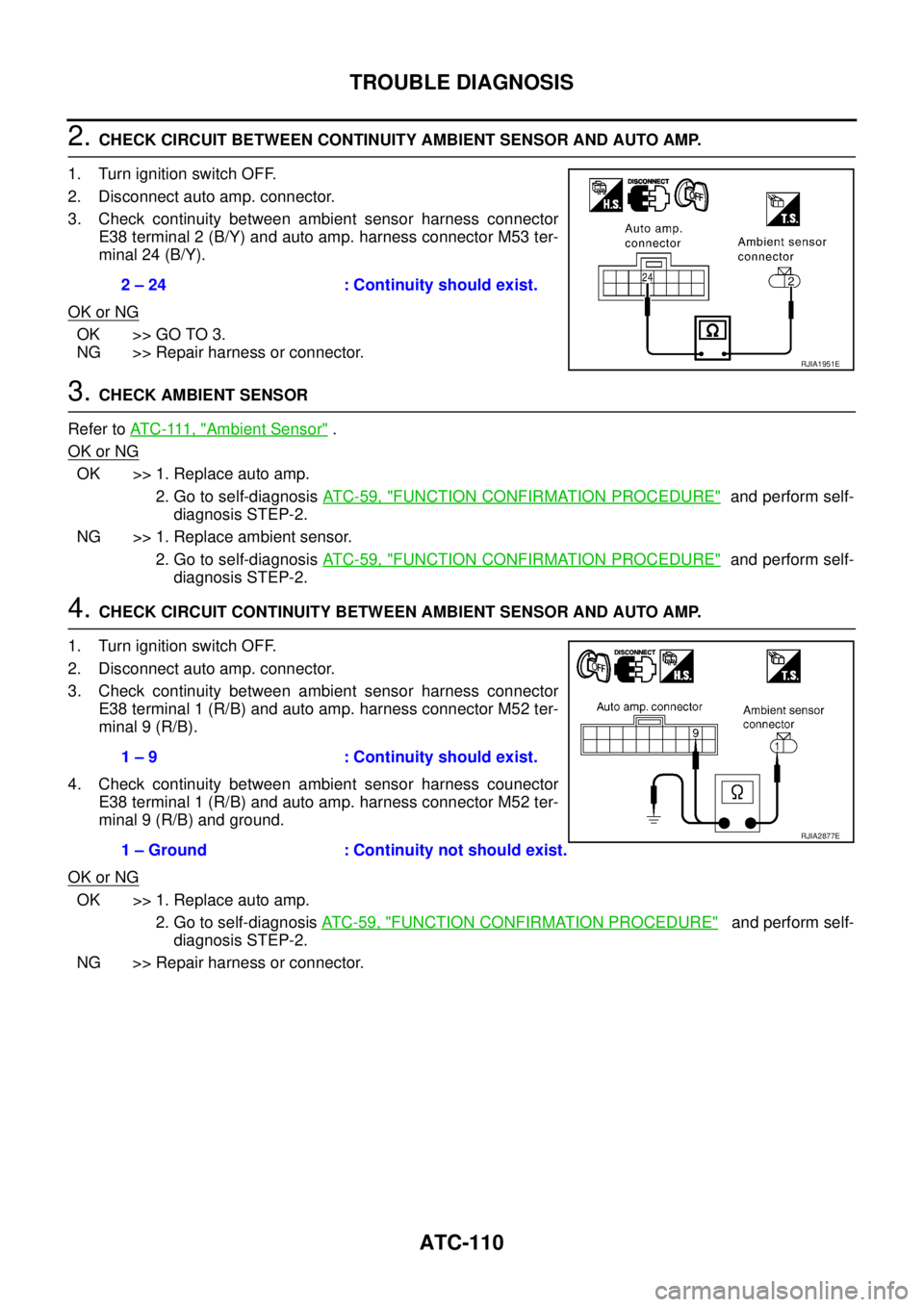
ATC-110
TROUBLE DIAGNOSIS
2. CHECK CIRCUIT BETWEEN CONTINUITY AMBIENT SENSOR AND AUTO AMP.
1. Turn ignition switch OFF.
2. Disconnect auto amp. connector.
3. Check continuity between ambient sensor harness connector
E38 terminal 2 (B/Y) and auto amp. harness connector M53 ter-
minal 24 (B/Y).
OK or NG
OK >> GO TO 3.
NG >> Repair harness or connector.
3. CHECK AMBIENT SENSOR
Refer to AT C - 111 , "
Ambient Sensor" .
OK or NG
OK >> 1. Replace auto amp.
2. Go to self-diagnosis AT C - 5 9 , "
FUNCTION CONFIRMATION PROCEDURE" and perform self-
diagnosis STEP-2.
NG >> 1. Replace ambient sensor.
2. Go to self-diagnosis AT C - 5 9 , "
FUNCTION CONFIRMATION PROCEDURE" and perform self-
diagnosis STEP-2.
4. CHECK CIRCUIT CONTINUITY BETWEEN AMBIENT SENSOR AND AUTO AMP.
1. Turn ignition switch OFF.
2. Disconnect auto amp. connector.
3. Check continuity between ambient sensor harness connector
E38 terminal 1 (R/B) and auto amp. harness connector M52 ter-
minal 9 (R/B).
4. Check continuity between ambient sensor harness counector
E38 terminal 1 (R/B) and auto amp. harness connector M52 ter-
minal 9 (R/B) and ground.
OK or NG
OK >> 1. Replace auto amp.
2. Go to self-diagnosis AT C - 5 9 , "
FUNCTION CONFIRMATION PROCEDURE" and perform self-
diagnosis STEP-2.
NG >> Repair harness or connector.2 – 24 : Continuity should exist.
RJIA1951E
1 – 9 : Continuity should exist.
1 – Ground : Continuity not should exist.
RJIA2877E
Page 3289 of 4555
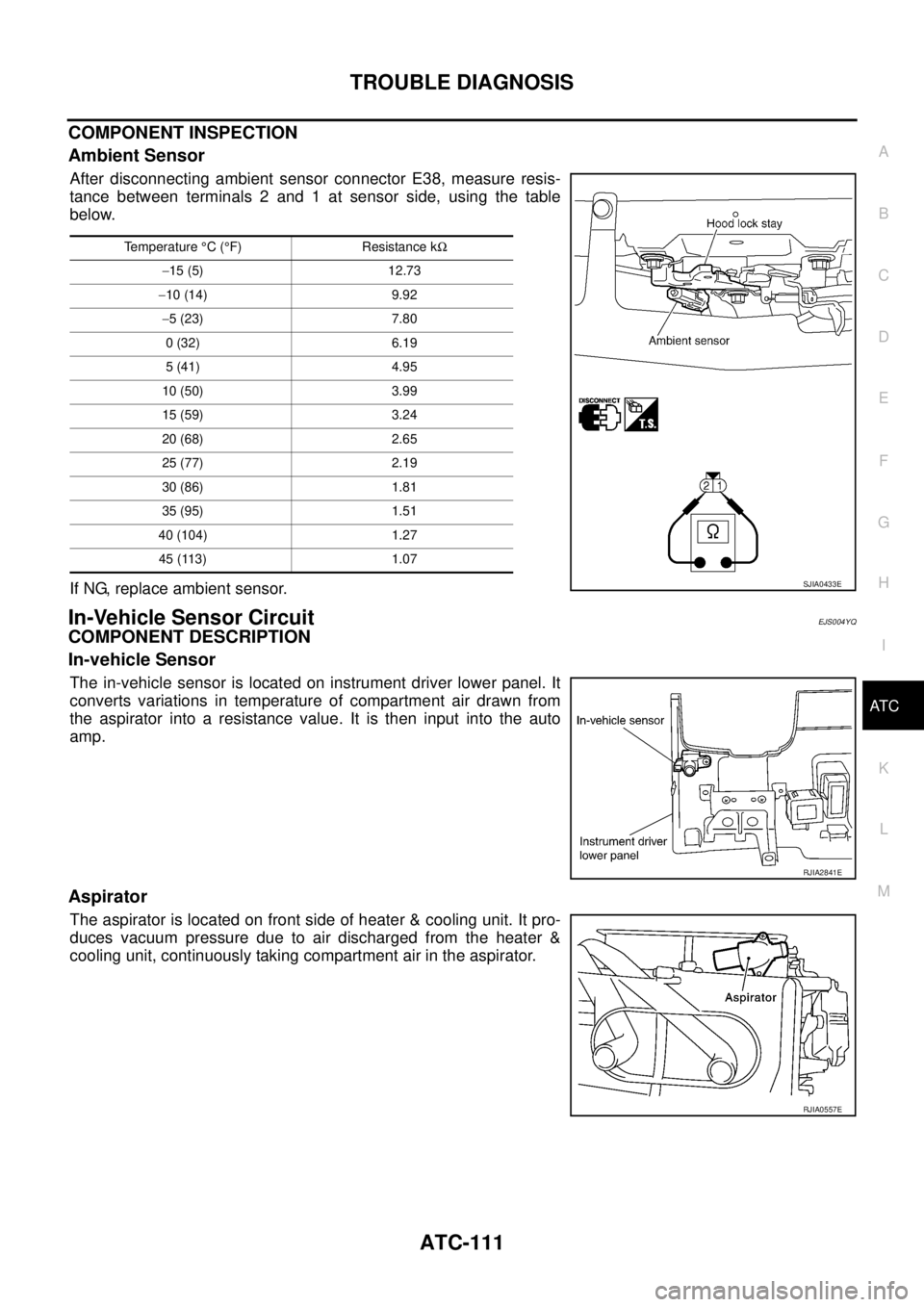
TROUBLE DIAGNOSIS
ATC-111
C
D
E
F
G
H
I
K
L
MA
B
AT C
COMPONENT INSPECTION
Ambient Sensor
After disconnecting ambient sensor connector E38, measure resis-
tance between terminals 2 and 1 at sensor side, using the table
below.
If NG, replace ambient sensor.
In-Vehicle Sensor CircuitEJS004YQ
COMPONENT DESCRIPTION
In-vehicle Sensor
The in-vehicle sensor is located on instrument driver lower panel. It
converts variations in temperature of compartment air drawn from
the aspirator into a resistance value. It is then input into the auto
amp.
Aspirator
The aspirator is located on front side of heater & cooling unit. It pro-
duces vacuum pressure due to air discharged from the heater &
cooling unit, continuously taking compartment air in the aspirator.
Temperature °C (°F) Resistance kΩ
−15 (5) 12.73
−10 (14) 9.92
−5 (23) 7.80
0 (32) 6.19
5 (41) 4.95
10 (50) 3.99
15 (59) 3.24
20 (68) 2.65
25 (77) 2.19
30 (86) 1.81
35 (95) 1.51
40 (104) 1.27
45 (113) 1.07
SJIA0433E
RJIA2841E
RJIA0557E
Page 3290 of 4555
ATC-112
TROUBLE DIAGNOSIS
DIAGNOSTIC PROCEDURE FOR IN-VEHICLE SENSOR
SYMPTOM: In-vehicle sensor circuit is open or shorted.
LED of A/C switch does not illuminate as a result of performing self-
diagnosis STEP-2.
1. CHECK VOLTAGE BETWEEN IN-VEHICLE SENSOR AND GROUND
1. Disconnect in-vehicle sensor connector.
2. Turn ignition switch ON.
3. Check voltage between in-vehicle sensor harness connector
M34 terminal 1 (P) and ground.
OK or NG
OK >> GO TO 2.
NG >> GO TO 4.
2. CHECK CIRCUIT CONTINUITY BETWEEN IN-VEHICLE SENSOR AND AUTO AMP.
1. Turn ignition switch OFF.
2. Disconnect auto amp. connector.
3. Check continuity between in-vehicle sensor harness connector
M34 terminal 2 (B/Y) and auto amp. harness connector M53 ter-
minal 24 (B/Y).
OK or NG
OK >> GO TO 3.
NG >> Repair harness or connector.
RJIA1402E
RJIA0745E
1 – Ground : Approx. 5V
RJIA2022E
2 – 24 : Continuity should exist.
SJIA0434E